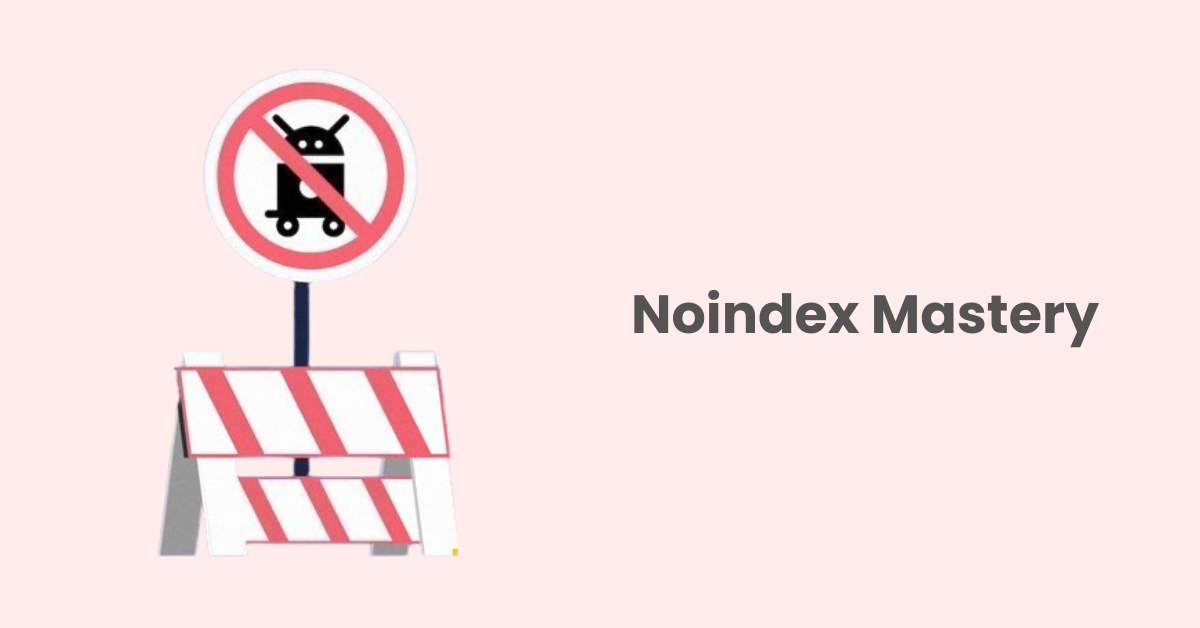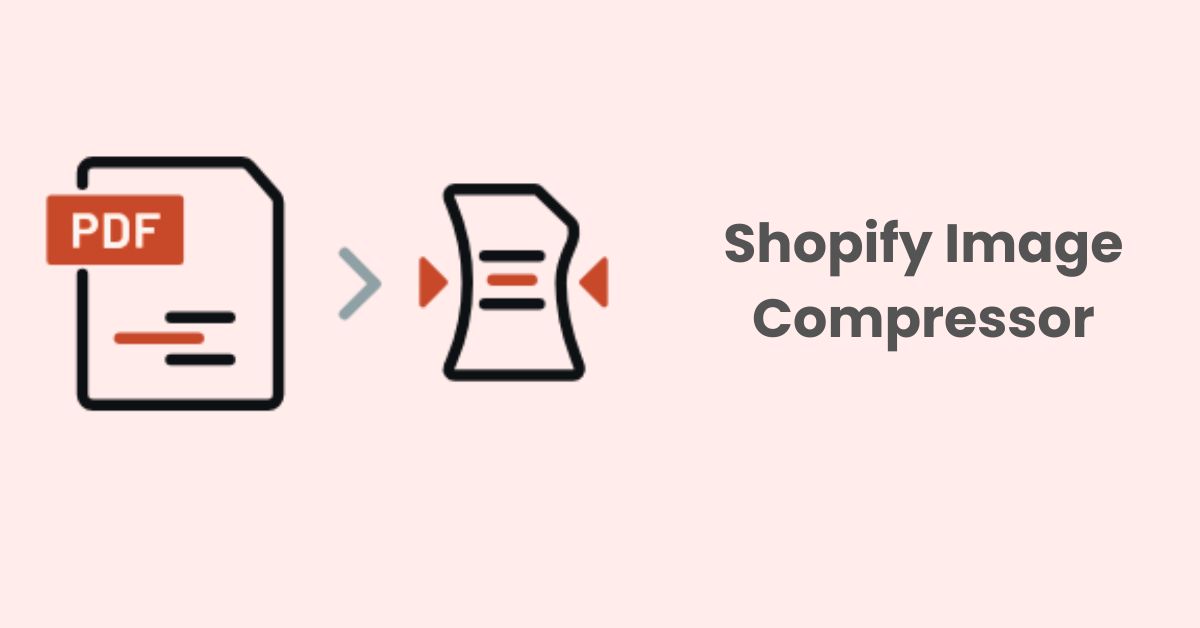Complete guide to Meta Descriptions on Shopify
As a Shopify store owner, you know that SEO is essential for driving traffic to your website and increasing sales. However, SEO isn’t always easy to understand or implement. One of the most important SEO tactics is optimizing your meta descriptions, which can help to ensure that your website is visible to search engines and visitors alike.
In this article, we’ll take a look at what meta descriptions are, the benefits of optimizing them, how to write SEO-friendly meta descriptions, best practices for optimizing meta descriptions, and how to add these essential tags to your pages.
What are Meta Descriptions?
Meta descriptions are HTML attributes that provide a brief description of a page. They are typically displayed by search engines in search results, and they help to inform users about the content of a page before they click on it.
They are a key part of SEO, contributing to increase click-through rates and promote your website to potential visitors.
Meta descriptions can be used to describe a wide range of content, including products, blog posts, articles, and services. However, they are most commonly used to describe web page content.
They are typically limited to around 160 characters, and they should include relevant keywords and phrases that accurately describe the page’s content.
Benefits of Optimizing Meta Descriptions
Optimizing meta descriptions can have a number of benefits for Shopify store owners, including:
- Improving visibility in search engine results pages (SERPs). Meta descriptions can help to make your website stand out from the competition and encourage users to click on your link.
- Boosting click-through rates. By using relevant keywords and phrases, you can ensure that your meta description is more likely to be clicked on.
- Increasing brand awareness. This is an effective way to promote your brand, as they can help to make your website more recognizable to potential customers.
- Enhancing the user experience. Optimizing your meta descriptions can help to make sure that visitors are directed to the most relevant page on your website, which can help to improve their overall experience.
How to Write SEO-Friendly Meta Descriptions
Writing SEO-friendly meta descriptions requires a bit of creativity, but it’s not as difficult as it may seem. To write effective meta descriptions, you should:
- Use relevant keywords and phrases. Make sure to include relevant keywords and phrases that accurately describe the page’s content. This will help to ensure that search engine crawlers can easily identify the page’s content and display it in search results.
- Keep it concise. Meta descriptions should be concise and to the point. Avoid using too many words, as this can make the description hard to read and difficult to understand.
- Make it unique. Each page on your website should have a unique meta description that accurately reflects the page’s content. If multiple pages have the same meta description, it can be difficult for search engine crawlers to accurately identify the content and display it in search results.
- Include a call to action. A call to action can help to encourage users to click on your link, so make sure to include one in your meta description.
Best Practices for Optimizing Meta Descriptions
There are a few best practices that you should keep in mind when optimizing meta descriptions for your Shopify website. These include:
- Keep it short. Meta descriptions should be between 150 and 160 characters, so make sure to keep your descriptions within this limit.
- Use actionable language. Try to use actionable language that encourages users to click on your link.
- Don’t use duplicate descriptions. Duplicate meta descriptions can confuse search engine crawlers and may not be displayed in search results.
- Include keywords. Make sure to include relevant keywords and phrases in your meta descriptions to help search engine crawlers accurately identify your page’s content.
Examples of Good Meta Descriptions
Here are a few examples of good meta descriptions that you can use as a guide:
- “Shop the latest collection of clothing, shoes, and accessories for men and women at [Your Shopify Store]. Find the perfect outfit for any occasion!”
- “Discover the best selection of organic and eco-friendly products at [Your Shopify Store]. Shop our range of sustainable items today!”
- “Get your hands on the best gadgets and electronics at [Your Shopify Store]. Browse our selection of top-rated items today!”
How To Add Meta Descriptions To Shopify Stores
Add Them Manually In The Shopify Admin Panel
Merchants can modify the meta title and description of web pages using the Shopify admin panel. Below are the steps to adjust the meta title and meta description for different web pages on Shopify.
Homepage
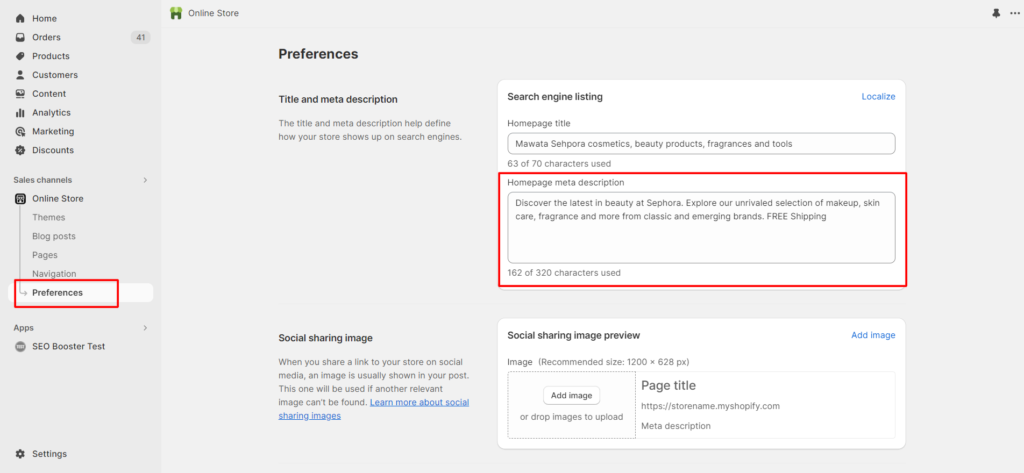
To set the title and meta description for your Shopify homepage, do the following:
- Navigate to your Shopify store’s admin panel and select “Online Store” from the “Sales Channels” section on the left.
- Choose the “Preferences” tab.
- Enter your desired homepage title and meta description in the provided text boxes.
- Click the “Save” button located in the top-right corner.
Product Pages
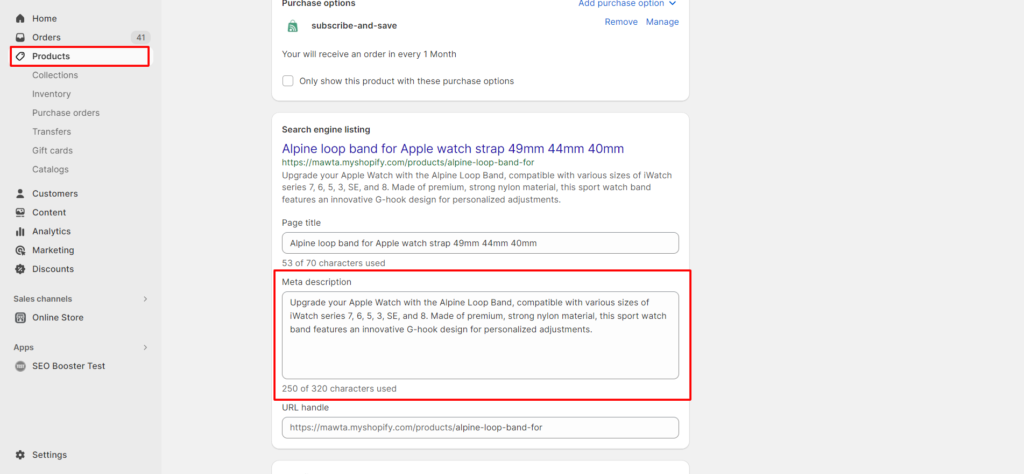
To modify the title and meta description for your Shopify product pages, proceed as follows:
- Access your Shopify store’s admin panel and select “Products” from the menu on the left.
- Choose the product you wish to update.
- Scroll to the bottom to locate the “Search engine listing” section, then click the “Edit” button.
- Adjust the page title and meta description as desired.
- Hit the “Save” button positioned in the top-right corner.
Collection Pages
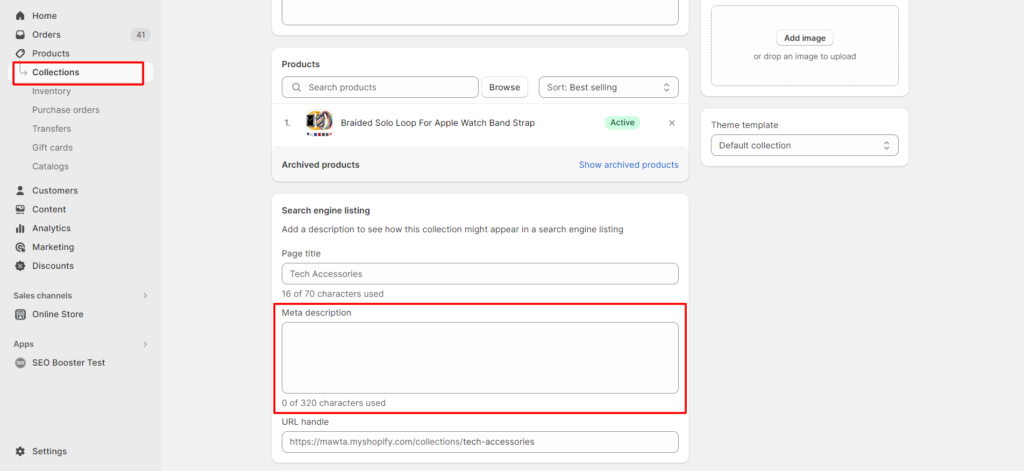
To adjust the title and meta description for your Shopify collection pages, follow these steps:
- In your Shopify store’s admin panel, navigate to the “Collections” tab found under the “Products” menu on the left.
- Select the collection page you’d like to modify.
- Scroll downwards to locate the “Search engine listing” section, then press the “Edit” button.
- Update the page title and meta description as needed.
- Click the “Save” button located in the top-right corner.
Other Pages
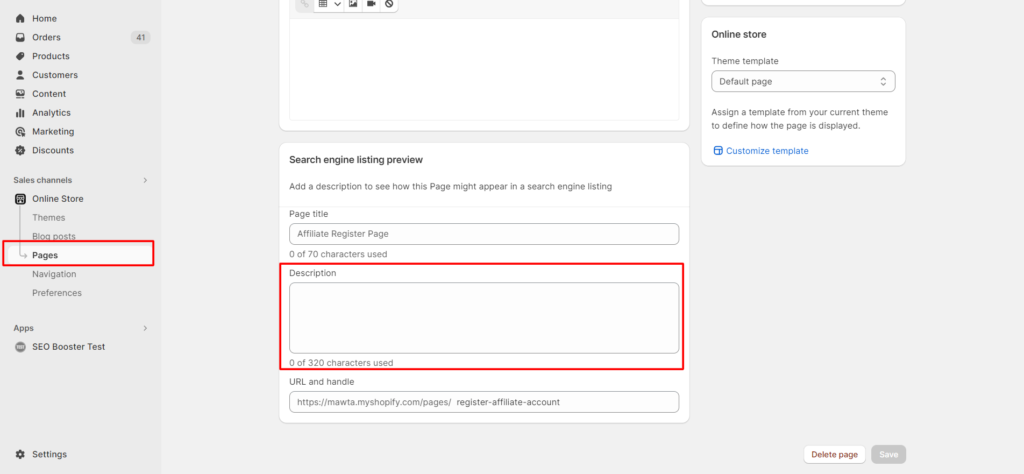
To update the title and meta description for other/general pages in your Shopify store, adhere to these steps:
- Access your Shopify store’s admin panel and select “Online Store” from the “Sales Channels” section on the left.
- Navigate to the “Pages” tab.
- Choose the page you’d like to update.
- Scroll down until you reach the “Search engine listing” section, then click the “Edit website SEO” button.
- Modify the page title and description as desired.
- Press the “Save” button situated in the top-right corner.
Add Meta Descriptions In Bulk With The SearchPie App
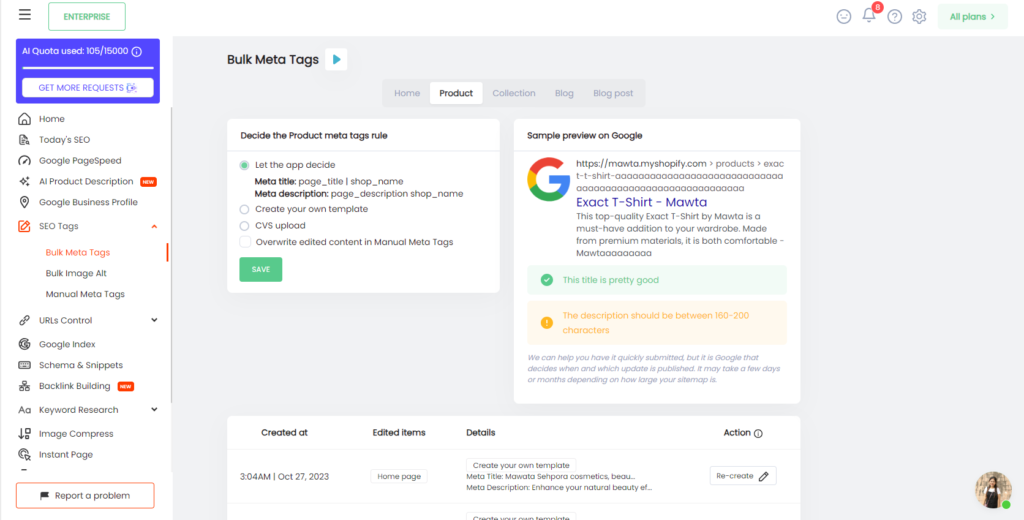
With the SearchPie app, you can efficiently update your website’s meta tags in bulk to save much time and effort, especially when you have to deal with tons of product pages and blog posts.
Let’s follow the below step-by-step guide:
- Accessing the Feature: open SearchPie and go to SEO Basic > SEO Tags > Bulk Meta Tags.
- Choose Page Type: Home, Product, Collection, Blog, or Blog Posts.
- Optimization Options:
- Let the App Decide: SearchPie auto-adjusts the title to the format:
page_title | shop_name - page_description shop_name. - Create Your Own Template: this allows you to manually customize your meta tags using available tags.
- Let the App Decide: SearchPie auto-adjusts the title to the format:
- Overwrite Previous Edits: If you’ve made edits in the “Manual Meta Tags” section before and wish to replace them with your new bulk meta tags, ensure you check the “Overwrite edited content in Manual Edit SEO” option.
Last but not least, don’t forget to review and save the changes you’ve made.
Write Optimized Meta Descriptions With The SearchPie App
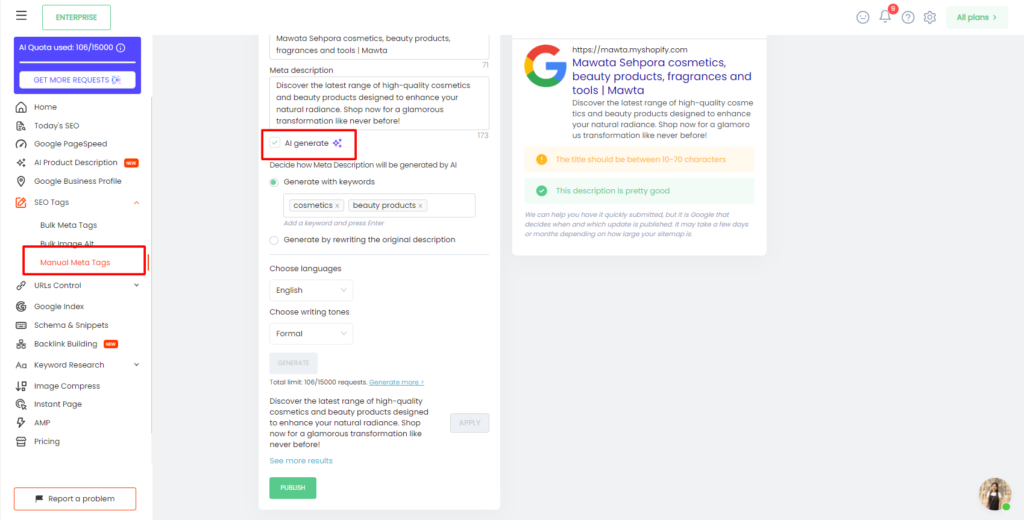
While Bulk Meta Tags is a very efficient tool to add meta descriptions, it uses fixed attributes from your pages, such as page_description and shop_name. Thus, sometimes this feature generates descriptions that are too long or too short.
However, there’s a solution in the app to address this. By integrating AI, users can manually craft meta descriptions that align better with SEO practices. Here’s how:
- Start by navigating to SEO Tags and selecting Manual Meta Tags.
- Make sure the AI Generated option is active.
- You’ll then input your chosen keywords, either crafting a new meta description or opting to rewrite the existing ones.
- Tab Generate to have your meta descriptions written by AI
- Let’s review the AI-crafted description. Once you are satisfied, simply hit Apply.
- Tab Publish to save the changes
By leveraging the AI capabilities within the app, you can create concise and effective meta descriptions.
Conclusion
Meta descriptions are an important part of Shopify SEO, as they can help to improve your website’s visibility in search engine results and increase click-through rates.
Optimizing your meta descriptions can be a bit tricky, but it’s worth the effort as it can help to ensure that your website is seen by potential customers. There are a number of Shopify tools and services that can help to improve your website’s SEO, so make sure to take advantage of them.
With the right strategy, you can ensure that your website is visible to search engines and visitors alike.

